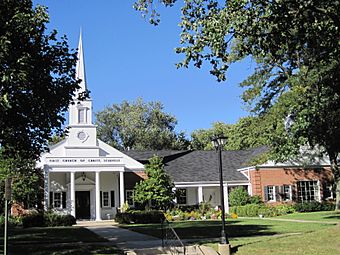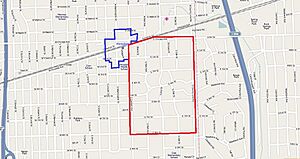Robbins Park Historic District facts for kids
Quick facts for kids |
|
|
Robbins Park Historic District
|
|

The First Church of Christ, Scientist, designed by Solon Spencer Beman
|
|
| Location | Bounded by Chicago Av, 8th St, County Line Rd, Garfield St Hinsdale, DuPage County, Illinois, U.S. |
|---|---|
| Architectural style | Late Victorian, Italianate, Queen Anne, Late 19th and 20th Century Revivals, Colonial Revival, Renaissance Revival, Bungalow, American Craftsman, Gothic Revival, Shingle Style, Romanesque Revival, Late 19th and 20th Century American Movements |
| NRHP reference No. | 08001098 |
| Added to NRHP | November 26, 2008 |
The Robbins Park Historic District is a special area in Hinsdale, Illinois, with many buildings. About 232 of these buildings are important because of their history. A man named William Robbins planned the layout of this district in the 1860s and 1870s. This happened after the Chicago, Burlington and Quincy Railroad train line was finished. Starting in the 1890s, rich business people began moving to the district. They liked its natural beauty and how close it was to big golf courses. The Robbins Park Historic District was added to the National Register of Historic Places in 2008. It even includes two houses that were already famous on the register!
Contents
A Look Back: History of Robbins Park
The Chicago, Burlington and Quincy Railroad (CB&Q) train line started running in 1862. Two years later, a train station was built in what is now Hinsdale. Before the station, a land developer named William Robbins bought a large area of land, about 700 acres (2.8 square kilometers). This was the first land bought in Hinsdale, and it included a spot for his own home.
Planning the Town
In 1866, Robbins planned the layout of the Town of Hinsdale. Most of this land was south of the train tracks. He advertised the land in Chicago newspapers. He also built small houses (cottages) and a school to encourage people to move there. Robbins added more land to the town later in 1866 and again in 1871.
For the 1871 addition, Horace W. S. Cleveland was hired to design the streets. He used a "curvy" style instead of the usual "grid" pattern (straight streets like a checkerboard). Curvy plans were good because they worked around natural features like big trees and hills. This helped protect the local environment. The Robbins Parks Addition was one of Cleveland's first projects in the Midwest.
Hinsdale Grows
The Great Chicago Fire happened in 1871. After this big fire, many people from Chicago thought about moving to the suburbs. This caused Hinsdale's population to grow very quickly. The Highlands train station, which is just north of the Robbins Park district, was added to the CB&Q line in 1873. By this time, Hinsdale had about 1,500 people.
Hinsdale invested money to improve its public services. This led to running water, electricity, and a sewage system for the town. Streets were paved with asphalt and brick. In 1899, the Hinsdale Golf Club opened west of Hinsdale. This made rich people want to live near the club. Hinsdale became known as one of Chicago's most beautiful suburbs. Several newspapers and magazines praised the town's beautiful buildings.
Important People in the District
Many local business people moved to the Robbins Park district.
- William Whitney was a member of the Illinois House of Representatives. He was the first person to suggest making Hinsdale an official town. His house is so important that it's listed on the National Register of Historic Places (NRHP) by itself.
- William Gibson Barfield was a local architect. He designed the Hinsdale Theater and the Hinsdale State Bank. He also designed many homes in the Robbins Park area.
- Howard George Hetzler was the President of the Metropolitan West Side Elevated Railroad. He was also in charge of the Chicago part of the CB&Q train line.
- Charles G. Root was a partner in a big company called the United States Gypsum Corporation.
- Orland P. Bassett was the first person to sell the famous American Beauty rose flower commercially. His house is also listed on the NRHP.
Building Styles: Architecture in Robbins Park

The very first homes in the district were built in the Gothic Revival style. This includes William Robbins' own house. The most popular style of building in the district is Colonial Revival, with 63 buildings. Most of the structures are from the Late Victorian era. However, there are also some newer designs like American Craftsman and bungalow homes.
You can find four houses designed in the Italianate style. There are also 32 homes built in the Queen Anne style. The district is mostly homes, but it also has four churches and two businesses that are not considered historically important.
Famous Architects
Many well-known architects designed buildings in Robbins Park:
- The company Shepley, Rutan and Coolidge from Boston, Massachusetts, designed the George H. and Carrie R. Mitchell House in 1893.
- Eben Ezra Roberts designed the Albert Wilson True House in 1910. This house is in the Prairie School style.
- John S. Van Bergen, who was also from Oak Park, designed the Harold Klock Residence in 1923.
- The firm Schmidt, Garden and Erickson designed two Colonial-style homes, built in 1934 and 1937.
- Solon Spencer Beman designed the first company town of Pullman, Illinois. He also designed the Church of Christ, Scientist building in the district in 1951.



